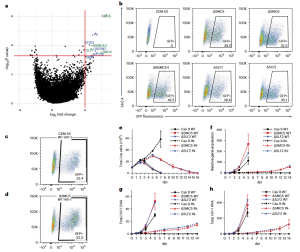Human immunodeficiency virus (HIV) appears to be driven into a latent condition, lying in cells only to lyse once again, by a process that likely developed to help combat infections, according to experts. In a recent paper, researchers offer fresh understandings into the perplexing mechanism that not only renders HIV extremely elusive but may also be involved in other viral diseases (Figure 1).

Figure 1: Screen identifies a role for SMC5/6 in silencing unintegrated HIV-1 DNA. a, Volcano plot of the mean fold change of sgRNAs specific for each gene and their false discovery rate (FDR)-corrected P values. Genes with fold change >16 and P value <0.0005 (delineated by the red lines) are labelled. Briefly, P values for individual sgRNAs were calculated using a negative binomial (NB) model, then sorted sgRNA P values were used to calculate FDR-corrected P values for individual genes using the robust rank aggregation (αRRA) algorithm in MAGeCK-VISPR 50,51. Members of the SMC5/6 complex are in green (FDR-corrected P values: SMC5 = 7.8 × 10 −7 , SMC6 = 0.00033, NSMCE3 = 0.00010, SLF1 = 0.00017). b, Flow cytometry of WT CEM-SS cells and the indicated clonal knockout cell lines at 2 dpi with an IN− NL-GFPΔEnv reporter virus at an MOI of ~0.3. A representative experiment from 3 biological replicates is shown. c,d, Flow cytometry of WT (c) or ΔSMC5 CEM-SS (d) cells at 2 dpi with IN+ NL-GFPΔEnv reporter virus at an MOI of ~0.3. Representative experiments from 3 biological replicates are shown. e–h, Time course of the infection of the parental CEM-SS Cas9 cells, or the ∆SMC5 and ∆SLF2 CEM-SS clones with IN+ or IN− NL-NLuc. e, Live cells. f, Virally encoded NLuc expression. g, Total HIV-1 DNA. h, Total HIV-1 RNA expression quantified at the indicated dpi. All IN+ HIV-1-infected cultures died from viral cytopathicity by 7 dpi. DNA and RNA levels were quantified by qPCR and normalized to IN+ HIV-1-infected CEM-SS Cas9 cells at 1 dpi, which was set to 1. Mean ± s.d. of 3 biological replicates.
Due to a limited percentage of latently HIV-infected T-cells that are unaffected by both antiviral medications and the immunological response, HIV has been shown to be incurable. Even years after infection, these cells can break out of their dormant state and begin generating HIV, necessitating the usage of antiretrovirals for the rest of one’s life.
This study’s researchers discovered a protein complex called SMC5/6 that plays a key role in the maintenance and repair of host cell chromosomes. According to the research, the SMC5/6 protein complex initiates a mechanism that silences the DNA provirus before it integrates into a host cell’s chromosome in a small subset of infected cells. Even after integration, these proviruses are inactive and cause latent infections that do not become active until provoked. A chemical that prevents SMC5/6 from silencing provided encouraging findings as a potential treatment approach since it prevented the creation of latent HIV infections, according to the researchers.
Journal article: Irwan, I,D., et al., 2022. Epigenetic silencing by the SMC5/6 complex mediates HIV-1 latency. Nature Microbiology.
Summary by Stefan Botha










